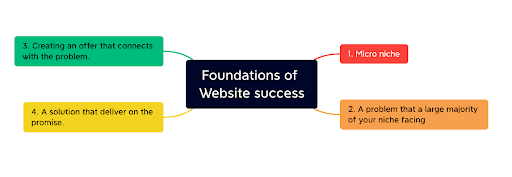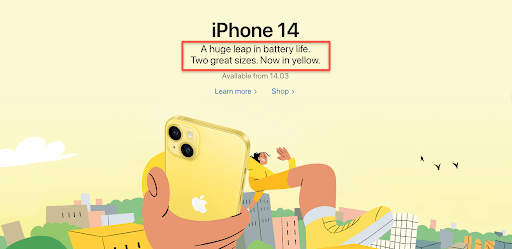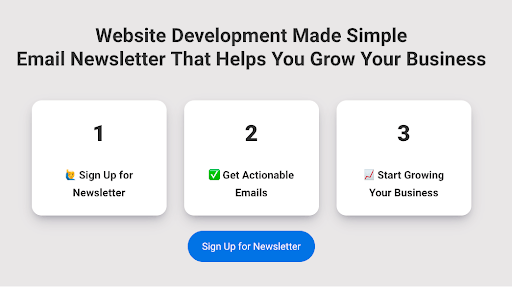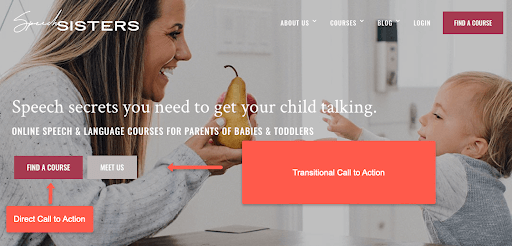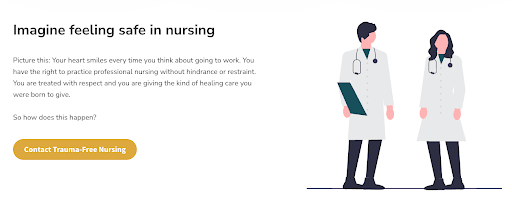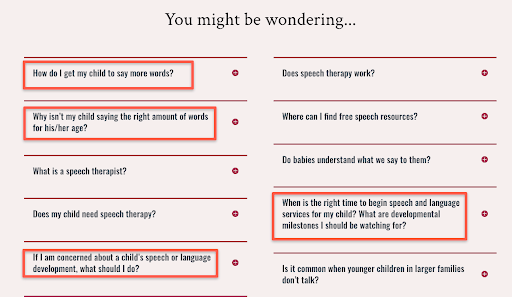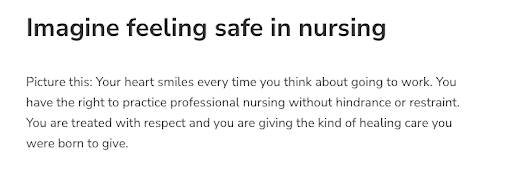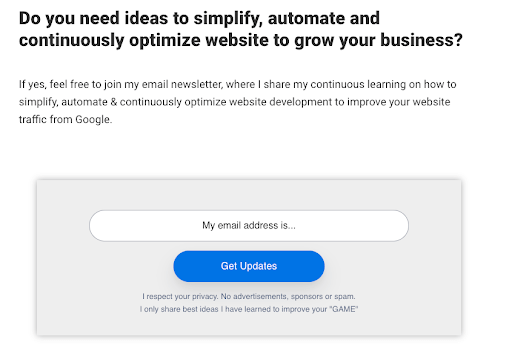This is a complete overview of the website basics to supercharge your website.
In this post, you’ll learn:
- Micro niche
- Your offer/solution
- StoryBrand brand-script
- Website goals
- Resources
If you’re starting a website development project, this website basics guide is for you to master website development fundamentals to make an informed decision for your website project.
By the end of this post, you’ll have a clear understanding of the following:
- Importance of the niche
- Role of your offer in your website’s success
- Why do you need a BrandScript before starting your website?
- Different types of websites and goals
- Recourses required for your chosen website goals
Let’s get started!
Micro niche
Focusing on the Micro-niche is your best choice to grow your business fast.
Let’s define the niche first before going into the micro niche.
What is a niche?
A dictionary definition of a niche is: “A specialised segment of the market for a particular kind of product or service.”
For example:
- Fashion
- Travel
- Technology
- Coaching
- Health And Wellness
- Finance
- Sports
- Real Estate
Above are different types of popular general niches.
Massive demand for solutions in these niches, and a considerable number of businesses compete in these general niches.
However, a few big players often control the majority of the market share.
For new businesses, it is difficult to cut through and build a profitable business in these generic niche markets for the following reasons.
- Severe competition
- Hard to innovate
- High cost of customer acquisition
- Challenging to deliver all sorts of services and products
- Maintain customer service and quality
A solution to these problems is to focus on the micro niche first and expand from there.
What is a micro niche?
A micro niche is a small segment of the general niche.
For example:
- Fashion > Clothing
- Travel > Holiday travel
- Technology > Website development
- Coaching > Life coaching
- Health and wellness > Mental health
- Finance > Personal finance
- Sports > Cricket
- Real estate > Residential property
Above niches are still too broad. You should keep going deeper or wider to find your goldmine niche.
- Fashion > Clothing > clothes for girls
- Travel > Holiday travel > packaged holidays
- Technology > Website development > Website development for creatives
- Coaching > Life coaching > Life coaching for health care professionals
- Health and wellness > Mental health > Mental health solutions for males over ’40s
- Finance > Personal finance > how to get out of debt
- Sports > Cricket > Cricket shoes
- Real estate > Residential property > Residential property HMO portfolio
The deeper you go into your niche, the better, as long as the market size stays commercially viable.
Why choose a micro niche?
Focusing on a micro niche helps you grow your business fast in several ways:
- Less competition
- Easy to innovate and connect with your target market
- Simple to create helpful and relatable content
- Quick to rank in search engines with less competition
- Fast business growth
- Much easier to establish yourself as an industry thought leader
Despite being the world’s most valuable company, Apple still positions itself as a niche brand. The iPhone accounts for only 15% of the global market in terms of sales but earns roughly 75% of the entire global market’s profits.
Ideas for exploring a micro niche?
Here are a few ideas to brainstorm micro-niche:
- Start with your main niche
- Explore the gap in the market
- Try age, location, gender, income, or a particular problem angle
- Don’t forget that your micro niche must be commercially viable once your plans are successful
A goal here is to find out the smallest possible micro niche that can provide you with the financial freedom you are hoping for.
Brian Dean is a well-known SEO expert and founder of Backlinko, a popular SEO blog. He started his blog in 2012 to provide high-quality SEO tips and advice to marketers and business owners.
He focused on a specific niche, which is SEO, and provided highly valuable and in-depth content to his audience.
What Brian Did:
- Focused on a micro niche: Brian chose to focus on a micro niche within the broader topic of digital marketing: SEO. He recognized that there was a massive demand for high-quality SEO tips and advice and decided to provide valuable and actionable content to his audience.
- Published highly valuable content: Brian’s content is highly valuable and in-depth. He spends a lot of time researching and creating his blog posts, often 2,000 to 4,000 words long. His content provides real value to his audience, which has helped him build a loyal following over the years.
- Leveraged various marketing channels: Brian leveraged various marketing channels, such as email marketing, social media, and SEO, to grow his blog and drive traffic to his website. He also used various lead magnets, such as free e-books and checklists, to attract new subscribers to his email list.
Results:
Brian’s approach has helped him grow his blog and business over the years. Today, Backlinko receives over 2 million monthly visitors and generates a significant amount of revenue through affiliate marketing and online courses. Brian’s success is a testament to the power of focusing on a specific niche and providing highly valuable content to your audience.
Your offer/solution
Have you chosen your micro niche?
If yes, life will be much easier, fulfilled, and happy moving forward.
It will be a lot easier to pick a problem your micro niche is facing and create a solution.
Four pillars of website success.
- Micro niche
- Figuring out a problem they are facing
- Creating an offer that resonates
- Delivering a solution that eases their pain
Most of your business success depends on these fundamentals.
You’ll do well in business if you can figure out these fundamentals. However, if you go wrong with these fundamentals, all the future hard work can be ruined.
One great example of creating an offer/solution that resonates with a micro niche is the case study of Laura Roeder. Laura founded MeetEdgar, a social media automation tool that allows businesses to schedule and automate their social media posts.
Laura identified a problem that her micro niche (small business owners) faced: the need for a simple and effective social media management tool. She created MeetEdgar as a solution to this problem and marketed it specifically to small business owners.
As a result of this focused approach, MeetEdgar was able to quickly gain traction and generate over $100,000 in monthly recurring revenue within a year of its launch. Laura’s success in creating an offer that resonates with her micro niche is a testament to the power of identifying a specific problem and providing a targeted solution.
💡Pro tip
Most people will be motivated to buy painkillers than vitamins. You should try to create a solution that solves your micro niche’s pain points.
StoryBrand brand-script
A StoryBrand brand script is the roadmap of all your marketing success. It is like the architect’s drawings when building a house.
Whenever you get confused, you refer to the architect’s plans.
It gives you complete clarity to create all your marketing collateral, not just a website. The StoryBrand brand script has seven elements you need to define to create an interesting story for your prospects.
And all stories start with…
A character 👨💼
Define what your customers want.
The clearer you define this, the more chances you have of engaging your customers in the story.
The problem 🤯
Your customers don’t buy your product or service.
They buy solutions to their problems, and you must define the problem clearly.
Your customers are only checking out your website because they have a problem.
You are in business 🤝 if you can define that problem clearly and offer a simple solution, they can easily understand.
The sink started to leak: You call the plumber.
Struggling to get a mortgage: You search for a mortgage broker.
Need to submit your annual accounts: You go to an accountant.
Define the problem your business solves clearly.
You can categorise the problem into the following categories.
Villain: Is there a root cause of your customers’ problems? Can you personify this root cause as the villain?
For example, the villain could be a complex website process when building a successful website.
External: What is a problem your customers deal with as it relates to your product or service?
A few examples of external problems in building a website include:
- Choosing a tech stack
- Finding a suitable hosting provider
- Choosing the appropriate tech stack
- Finding reliable developers
- Time required to build a website
- How to compete in the search results
By being aware of these external problems, a website development consultant helps you prepare for potential challenges and build a website to help you grow your business.
Internal: How is this villain making your customers feel?
You can face several internal problems while building a website.
These problems include:
- Lack of clarity in website goals
- Unclear niche
- Vague content strategy
By addressing these internal problems, website development consultants guide you in building a website that helps you grow your business.
Philosophical: How is this villain making your customers feel?
The philosophical problem people face when developing a website is often related to the purpose and the target audience of the website. Many people tend to focus on the design and technical aspects of the website without giving enough thought to the messaging and the overall user experience.
The guide 🙋♂️
This is the biggest paradigm shift you’ll encounter in the StoryBrand framework.
You should not represent yourself as a hero in a story you are trying to communicate on your website. Your customer is the hero who is searching for a guide to solve a problem and win a day.
- You are not a Karate Kid; you are Mr Miyagi.
- You’re not Harry Potter. You’re Dumbledore.
- You’re not Sherlock Holmes. You’re Dr Watson.
You must position yourself as a guide on your website and in all your marketing collaterals.
You can do this on your website homepage with a brief statement expressing empathy, understanding, and authority.

The plan ✍️
After establishing the authority, you must give your customers a simple no more than four, ideally, three steps plans to start working with you and list the agreements you can make with your customers to alleviate their fears of doing business with you.
We all are busier than ever. You should not leave anything on chance.
Calls to action ✅
As a guide, customers rely on your guidance and don’t take action unless they have been challenged.
You must have crystal clear two calls to action on your website.
- Direct calls to action, such as buy now.
- Transitional calls to action that help you get in touch with the customers again, such as a free download in exchange for an email id.
Both of these calls to action must be the most prominent on your website.
The success 🙌
Nothing can help you get more attention from your customer than a success story.
A few ways to include success stories on your website homepage.
- Case studies
- Testimonials
- Your product or service benefits
The stakes/failure 😩
Your customers landed on your website because something is at stake, and they are looking for a solution.
You must clearly communicate what’s at stake on your website if they leave without doing business with you to increase the conversion rate.
Here is an example of the negative consequences your customer will experience if they don’t use your product or service.
Speech Sisters are communicating states and addressing concerns through faqs.
Character transformation (From – to)
Your brand script should be a roadmap for you to take your character (ideal customer) from point a to point b.
From: How did your customers feel about themselves before using your product or service?
To: Who will your customers become after using your product or service? What is their aspirational identity?
Meyer’s Pet Care is a doggy daycare service in Chicago that provides dogs with a safe and fun environment while their owners are away. They offer various services such as daycare, boarding, grooming, and training to ensure every dog is well-cared for and happy.
Challenge:
Meyer’s Pet Care faced several challenges in Chicago’s highly competitive pet care industry. They struggled to stand out from their competitors and attract new customers. Their website lacked a clear message and didn’t effectively communicate their services and unique selling proposition. Their social media presence was inconsistent and didn’t showcase their services and facilities.
Solution:
The owner, Gwen Meyer, went through the StoryBrand online marketing workshop to clarify their message and improve their marketing efforts.
She developed a brand script that emphasized their unique approach to pet care and highlighted the benefits of their services. Also, created a new website that incorporated the brand script and featured high-quality images and videos of their facilities and services.
Results:

Meyer’s Pet Care’s success story demonstrates the power of the StoryBrand framework to transform a business’s marketing efforts. By clarifying its message and emphasizing its unique approach to pet care, they were able to differentiate itself from its competitors and attract new customers.
With the right marketing strategy and execution, any business can achieve similar success.
Website goals
Websites are like cars and come in different shapes and sizes. Different types of cars are made to achieve different objectives.
For example:
- Sedan. A four-door is a small to medium size car made for individuals and small families.
- SUV. A spacious vehicle ideal for large families, more storage, and long-distance journeys.
- Van. Comes in different sizes. It can be used to carry up to 20 people or for industrial shipment purposes.
- Truck. The main purpose of a truck is to carry cargo.
Similarly, there are different types of websites, and you should choose wisely as per your needs.
Here are six common types of websites, including their goals.
#1. Online business card
The most common goal of the website for every business is to have an online presence.
These websites are also often referred to as brochure websites and usually have the following pages:
- Home
- About
- Services/products
- Contact
- Legals
These types of websites are easy and cost-effective to build.
However, these websites generally don’t attract organic traffic from search engines.
The common sources of traffic to these types of websites are:
- Word of mouth
- When you share your business cards
- Referral traffic from your social media outreach
- Paid advertisement
- Someone searches by business name
- Local SEO
#2. Authority building
A goal of this type of website is to establish yourself as an authority in your niche.
It is possible to achieve that by adding the following to your online business card or brochure website:
- Content-rich guides: Consider your website as your business book and create 5-10 content-rich guides (book chapters) to share expert knowledge and build authority.
- Resource pages: Adding tried and tested resource page adds authority to your website and can be a good source of earning backlinks.
- A free tool: Adding a free tool to save time for your audience can be a big authority booster.
An authoritative website gives you a good chance to grow your business online organically.
#3. Lead generation tool
If your website goal is to create a lead-generation tool to grow your business.
You need to go further with your authority website and include the following to convert your website into a lead-generation machine.
A blog
Do you know the search engine ranks all indexed pages in search results, not only your website homepage?
In theory, the more SEO-optimised rich content pages you have on your website, the more chances you have to rank in search engines.
A blog is a fantastic tool that gives you the ability to create regular content and increase the chances of getting more traffic from search engines.
| Pros | Cons |
| Build authority | A learning curve |
| Improves SEO | Time-consuming |
| Increase traffic | Consistency can be challenging for most |
| Generate better leads | Most niches are too competitive |
| Helps you with networking and collaboration | This can lead to a burnout |
| You can repurpose blog content for your social media publishing needs | |
| A successful blog has the power to build a massive business |
Content promotion
It is possible to attract organic search traffic by creating 10x better content along with mastering on-page/technical SEO.
However, most niches are competitive, and you need to make efforts to promote your content at least at the start until you get traction.
Here are a few ways to promote your blog posts and other helpful content.
- Share on social media
- Syndicate the content to other websites that have readers
- Drop your links in relevant forums, comment threads, and Twitter discussions
- Share with your email list
- Collaborate with influencers
- Test paid to advertise if you have a budget
- Use Local SEO
It is hard work; however, it can be a game changer once the organic traffic starts to kick in.
Landing pages
Building organic traffic is hard.
Unfortunately, it doesn’t end here.
Once you start getting traffic, then you usually have to keep finding ways to convert that traffic into leads and paying customers.
Landing pages help you direct your traffic to one way system of your website, where customers can buy your services or at least leave an email so you can connect with them in the future.
Lead generators
High converting landing page must have two calls to action.
Direct: Buy now, book now, schedule a call, or book a free discovery section, etc.
Transitional: Free guide, Email course, or sign up for your newsletter.
The simple and more useful your lead generator will be, the higher the conversion should be.
Email capture system
You need an email capture system for the above lead generators to work on your website.
All popular email marketing tools have the features to connect your lead generators to collect emails and run follow-up email campaigns.
Step 1: Create an email list on your email marketing system
Step 2: Connect your email list with your lead generator form on your website
Step 3: Deliver your lead generator’s offer, such as PDF or an email course using your email follow-up campaign in your email marketing software.
If you want to increase your conversion rate to capture more emails. You may want to check out advanced pop-up creation tools, which increase the email open rate.
I hope you have a clear idea of what goes into creating a lead-generation website.
#4. Customer services tool
The main goal of this type of website is to improve your customer experience and reduce your operational costs.
If you rely upon lead generation through your website, you can build a customer services tool alongside building your lead generation website.
However, you can also include a customer services feature with a business card website as well.
- Data collection
- Hotel or restaurant booking system
- Events booking through the website
- Appointment booking system
- Events directions
- Reporting a repair
- Collecting payments
- Customer knowledge base
Above are a few examples of what is possible to achieve.
#5. A Complete eCommerce solution
A common goal of this type of website is to run a complete online business. This type of website requires a much bigger budget, time, and skills.
A few examples are:
- A holiday booking website
- An online course website
- A complete eCommerce store
- A membership website
- A social networking site
- A business directory
- A complete back office system
I hope this has given you a clear understanding of different types of websites and the intended purposes of creating a particular website.
Ross Optical is a top-ranking supplier for OEMs in medical devices, automation, and other industries. They have an extensive portfolio of optical fabrication and quality assurance equipment, technology, technical solutions, and optical product suppliers.
Ross Optical faced an overall trend of declining conversion rates across landing pages throughout the website. To resolve this issue, their team worked together to update their website and goals to be cleaner with a design-focused landing page. The goal of Ross Optical was to increase conversions on the page, with good traffic but low submission rates.
After re-designing the pages by keeping their new goals in mind, the trend reversed, and their submission rate increased consistently. Landing page form submissions increased 55% from just a year alone.
Website Resources
Do you know what the most significant difference between someone who achieves their website goals and those who don’t is?
It’s a clear understanding of your website goals and the resources needed to achieve them.
I hope by now you have decided on your website goal(s), and it’s time to share the suggested resources you’ll need to increase the chances of achieving your website goals.
I have tried explaining the following website resources required for the different website goals.
- Time
- Investment
- Technical skills
- Industry knowledge
In the following table, you’ll have a clear picture of choosing a DIY route or going with an experienced website development consultant.
Time
| DIY | Website Consultancy | |
| Online business card | One week to a lifetime, depending on individual skillsets | 4-8 Weeks, which includes: ✅ Brand script ✅ One liner ✅ Homepage wireframe ✅ Lead generation system installation ✅ Sales campaign 5-7 emails ✅ Email nurture campaign ideas |
| Authority building | One month to a lifetime, depending on individual skill sets. | 3-6 Months This includes the following: ✅ Online business card Plus ✅ 5-10 content category selection ✅ 5-10 Resource pages ✅ Customer reviews/Case studies |
| Lead generation tool | Six months to a lifetime, depending on individual skill sets. | 6 Months plus This includes the following: ✅ Authority building plus ✅ 4-8 content pieces published each week ✅ Content promotion (Social media, forums, link building, paid ads) ✅ Consistent A/B testing to increase the conversion |
| Customer services tool | Subjective to the feature and technical skills. | Subjective on the feature. |
| A complete E-commerce solution | Subjective to the feature and technical skills. | Anywhere between 2-6 Months plus. |
Investment
| DIY | Website Consultancy | |
| Online business card | 1. Domain cost – $10-$15 a year 2. Hosting $100-$300 a year 3. A premium theme – $100 one-off 4. Premium plugins depending on your needs | $990 – $1485, which includes: ✅ Brand script ✅ One liner ✅ Homepage wireframe ✅ Lead generation system ✅ Sales campaign 5-7 emails ✅ Email nurture campaign ideas |
| Authority building | Online business card plus: Content creation will cost you time. You can get the exact cost using the following formula. Your hourly rate x hours spent on content creation and publication. Hour rate: $100 Hours spent: 40 Total DIY cost: $4000 | 3-6 Months – $495 per month. ($1485 – $2970) This includes the following: ✅ Online business card Plus ✅ 5-10 content category selections ✅ 5-10 Resource page briefs ✅ Customer reviews/Case studies |
| Lead generation tool | Content creation will cost you time. You can get the exact cost using the following formula. Your hourly rate x hours spent on content creation and publication. Hour rate: $100 Hours spent: 100 Total DIY cost: $10,000 | 6 Months plus $2970 will be the cost for 6 months plus your time to complete our content briefs. This includes the following: ✅ Authority building plus ✅ 4-8 content pieces published each week ✅ Content promotion (Social media, forums, link building, paid ads) ✅ Consistent A/B testing to increase the conversion |
| Customer services tool | Subjective to the feature and technical skills. | Subjective on the feature |
| A complete E-commerce solution | Subjective to the feature and technical skills. | $5000 plus. |
Technical skills
| DIY | Website Consultancy | |
| Online business card | Beginner – Intermediate level | None |
| Authority building | Intermediate – Expert level | None However, you must have an understanding of all website basics explained here. |
| Lead generation tool | Expert – Master level | None. However, you must understand all website basics explained here and have a long-term mindset. It is usually a marathon, not a 100-meter sprint. |
| Customer services tool | A clear understanding of what tool you need + expert-level technical skills | A clear understanding of what tool you need. |
| A complete E-commerce solution | Expert – Master level | A clear understanding of what tool you need and expertise in all the areas of running an online E-commerce business. Also, you must understand all website basics explained here and have a long-term mindset. It is usually a marathon, not a 100-meter sprint. |
Industry knowledge
| DIY | Website Consultancy | |
| Online business card | Basic – Good | Basic – Good |
| Authority building | Good – Expert | Good understanding of your niche. |
| Lead generation tool | Expert | Good understanding of your niche. Along with an understanding of all website basics explained here and a long-term mindset. It is usually a marathon, not a 100-meter sprint. |
| Customer services tool | Expert | Good understanding of your niche. |
| A complete E-commerce solution | Expert | Strong confidence in your business idea. Along with an understanding of all website basics explained here and a long-term mindset. It is usually a marathon, not a 100-meter sprint. |
Buildrite Construction Corporation is a nationwide building contractor with a variety of construction services to make any project a reality. They were struggling with low web traffic and zero monthly web leads. Also, the website speed was very poor, which greatly diminished their search engine rankings and lead generation.
Buildrite Construction Corporation wanted to build credibility and expertise in the construction space across the US. So, they redesigned Buildrite’s website to build credibility and demonstrate expertise. The approaches used by Buildrite were: SEO-friendly site architecture by creating a content taxonomy, creating a portfolio section to show off their excellent work to prospects, and Streamlining the lead gen process by making opportunities for online leads to connect with the sales team easily.
As a result of using the right approaches, after the new site launch, Buildrite saw improved YOY traffic by 46% and non-paid traffic by 70%. Additionally, the average session duration increased by 73%, and new user sessions increased by 23%. The new website generated approximately 15 qualified new leads from the old site’s zero monthly leads in the quarter after launch.
Conclusion
Congrats! ✌️👏
Hats off to you for reading a complete post, and I hope your understanding of website basics has improved.
After reading these website basics, can you decide what sort of website you should go for? If yes, the time spent writing this content is worth it.
If not, please let me know so I can improve it.
You can share your feedback by sending me an email. 👊🙏
Websites Made Simple Newsletter, one email a week, helps business owners and creatives build websites which help them grow their businesses.
By joining the email newsletter, you’ll get one actionable email every week to build and optimise your website.
Website Development Made Simple
Email Newsletter That Helps You Grow Your Business
1
🙋♂️ Sign Up for
Newsletter
2
✅ Get Actionable
Emails
3
📈 Start Growing
Your Business

